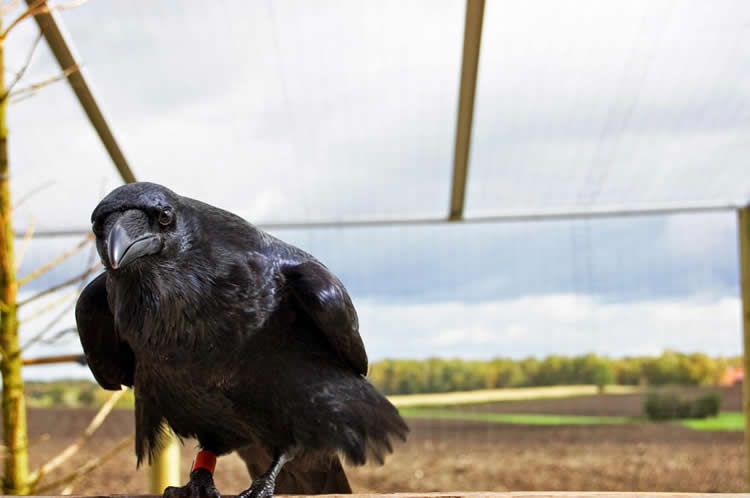A study led by researchers at Lund University in Sweden shows that ravens are as clever as chimpanzees, despite having much smaller brains, indicating that rather than the size of the brain, the neuronal density and the structure of the birds’ brains play an important role in terms of their intelligence.
“Absolute brain size is not the whole story. We found that corvid birds performed as well as great apes, despite having much smaller brains”, says Can Kabadayi, doctoral student in Cognitive Science.
Intelligence is difficult to test, but one aspect of being clever is inhibitory control, and the ability to override animal impulses and choose a more rational behaviour. Researchers at Duke University, USA, conducted a large-scale study in 2014, where they compared the inhibitory control of 36 different animal species, mainly primates and apes. The team used the established cylinder test, where food is placed in a transparent tube with openings on both sides. The challenge for the animal is to retrieve the food using the side openings, instead of trying to reach for it directly. To succeed, the animal has to show constraint and choose a more efficient strategy for obtaining the food.
The large-scale study concluded that great apes performed the best, and that absolute brain size appeared to be key when it comes to intelligence. However, they didn’t conduct the cylinder test on corvid birds.
Can Kabadayi, together with researchers from the University of Oxford, UK and the Max Planck Institute for Ornithology in Germany, therefore had ravens, jackdaws and New Caledonian crows perform the same cylinder test to better understand their inhibitory control.

The team first trained the birds to obtain a treat in an opaque tube with a hole at each end. Then they repeated the test with a transparent tube. The animal impulse would naturally be to go straight for the tube as they saw the food. However, all of the ravens chose to enter the tube from the ends in every try. The performance of the jackdaws and the crows came very close to 100%, comparable to a performance by bonobos and gorillas.
“This shows that bird brains are quite efficient, despite having a smaller absolute brain size. As indicated by the study, there might be other factors apart from absolute brain size that are important for intelligence, such as neuronal density”, says Can Kabadayi, and continues:
“There is still so much we need to understand and learn about the relationship between intelligence and brain size, as well as the structure of a bird’s brain, but this study clearly shows that bird brains are not simply birdbrains after all!”
Source: Cecilia Schubert – Lund University
Image Credit: The image is credited to Helena Osvath / Lund University.
Original Research: Full open access research for “Ravens, New Caledonian crows and jackdaws parallel great apes in motor self-regulation despite smaller brains” by Can Kabadayi, Lucy A. Taylor, Auguste M. P. von Bayern, and Mathias Osvath in Royal Society Open Science. Published online April 20 2016 doi:10.1098/rsos.160104
Abstract
Ravens, New Caledonian crows and jackdaws parallel great apes in motor self-regulation despite smaller brains
Overriding motor impulses instigated by salient perceptual stimuli represent a fundamental inhibitory skill. Such motor self-regulation facilitates more rational behaviour, as it brings economy into the bodily interaction with the physical and social world. It also underlies certain complex cognitive processes including decision making. Recently, MacLean et al. (MacLean et al. 2014 Proc. Natl Acad. Sci. USA 111, 2140–2148. (doi:10.1073/pnas.1323533111)) conducted a large-scale study involving 36 species, comparing motor self-regulation across taxa. They concluded that absolute brain size predicts level of performance. The great apes were most successful. Only a few of the species tested were birds. Given birds’ small brain size—in absolute terms—yet flexible behaviour, their motor self-regulation calls for closer study. Corvids exhibit some of the largest relative avian brain sizes—although small in absolute measure—as well as the most flexible cognition in the animal kingdom. We therefore tested ravens, New Caledonian crows and jackdaws in the so-called cylinder task. We found performance indistinguishable from that of great apes despite the much smaller brains. We found both absolute and relative brain volume to be a reliable predictor of performance within Aves. The complex cognition of corvids is often likened to that of great apes; our results show further that they share similar fundamental cognitive mechanisms.
“Ravens, New Caledonian crows and jackdaws parallel great apes in motor self-regulation despite smaller brains” by Can Kabadayi, Lucy A. Taylor, Auguste M. P. von Bayern, and Mathias Osvath in Royal Society Open Science. Published online April 20 2016 doi:10.1098/rsos.160104







